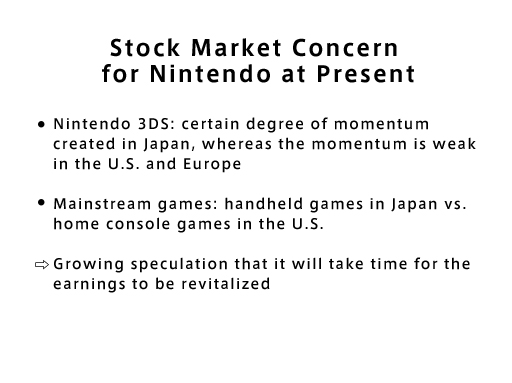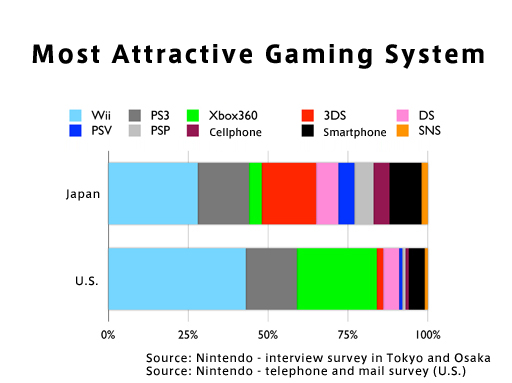Iwata: 3DS sales momentum overseas is “not so good”
Overall, 3DS sales have improved since the system’s initial launch. It is, however, still struggling a bit overseas.
Nintendo president Satoru Iwata told investors at a meeting last week that 3DS sales have stabilized in Japan and have some momentum. But in the U.S. and Europe, “the sales pace went down after the beginning of 2012.” Iwata believes the 3DS XL and New Super Mario Bros. 2 can improve the situation.
Iwata also commented on how “one of the difficulties Nintendo is facing in terms of spreading the Nintendo 3DS is the difference of the mainstream products between Japan, where the handheld video games are the main products, and the U.S., where the home console video games are the main ones.”
Read on below for his full response.
What we should say first is that while the Nintendo 3DS has a certain degree of sales momentum in Japan, the momentum in the U.S. and Europe is currently weak. To be more specific, sales of the Nintendo 3DS are constant in Japan and in fact we could say the sales volume is exceeding our forecast at the start of this fiscal year. After the beginning of this calendar year, the average unit sales have been 83,000 units on a weekly basis. This means that about 55% of all gaming hardware sales in Japan consist of the Nintendo 3DS. Now, with the level of sales momentum for the Nintendo 3DS created since the last year end, we would say the center of the Japanese video game market has been the Nintendo 3DS. This scenario is the scenario we were drawing at the beginning and in that regard, the growth is steady. On the other hand, sales momentum in the U.S and Europe is not so good. Considering that the U.S. and European markets are larger than the Japanese market in terms of the size of the population, sales in the U.S. and Europe are supposed to be larger. At the year end of 2011 the sales momentum in those markets increased in the same way as in Japan; however, the sales pace went down after the beginning of 2012. As a result, the sales proportion of the Nintendo 3DS is now about 20% of the total video game sales in those markets. Thus, solid sales momentum has not been created. For those investors who understand this situation, they might think that our earnings situation will not turn around in the way we have mentioned, or they might think it will take a much longer time than we expect to revitalize the profit situation. With the Nintendo 3DS XL I just spoke about and our key titles, such as “New Super Mario Bros. 2,” to be released globally this summer, one of our immediate top-priority missions is to create sales momentum which can wipe this type of concern away at an early stage.
On your note, one of the difficulties Nintendo is facing in terms of spreading the Nintendo 3DS is the difference of the mainstream products between Japan, where the handheld video games are the main products, and the U.S., where the home console video games are the main ones. Please take a look at this chart. The top bar represents Japan and the bottom bar represents the U.S. We are conducting surveys on a regular basis to consumers regardless of whether they play games or not by asking if they have played games during the past 12 months, with what game system they played games and how often they played games. This chart is the outcome of one of our regular surveys to consumers who played games during the last 12 months by asking, “What is the most attractive game hardware system for you?” The light blue area on the left represents the Wii, the grey one next to the Wii is PlayStation 3 for SONY, and the green one means Xbox 360 for Microsoft. To the right, the red area is the Nintendo 3DS, the pink one is the Nintendo DS, the dark blue one is PlayStation Vita, the light grey one is PlayStation Portable and the remaining colors represent games played on social networks, games for smartphones and games played on PC social networks. Now it’s been said that the competition is not just among dedicated game systems of Nintendo, Microsoft and SONY, so we intentionally added other choices to our survey. As you can see from the U.S. situation in the bottom bar, an overwhelming portion is covered by the three home console type video game systems. In the U.S., “video games” means home console video games. However, in Japan, those who say that video games mean home console games are only about half of all respondents, and handheld-type games have more significant appeal. The data we showed you are based on the survey in January this year in Japan and in March in the U.S. When we have updated information about the same survey and if there is a chance in the future, we would like to show you the results during occasions like the Financial Results Briefings. We think the difference in the sizes of the red areas represents the difference of the current momentum of the Nintendo 3DS. Meanwhile, for those who are well aware of the current video game business, the result appears not to reflect the present sales status at all. The reason why the Wii’s proportion is so high despite its sales situation not being so strong is, memories of playing with the Wii make such a strong impression on people that they remain in their minds, so the Wii is chosen as the most attractive game system even now. Conversely, for us to launch the Wii U, this is a very valuable asset and is considered favorable data. Since the shareholders and investors do not have these kinds of data, when they have pessimistic views on the Wii U, we think we may need to present the data like this to overcome such a view. For your reference, as it was the case with the Nintendo DS, it took a much longer time for the platform to gain sales momentum in the U.S. than in Japan. The Nintendo DS gained momentum within a year in Japan; however, it took more than two years in the U.S. and in the end the total sales of the Nintendo DS exceeded the Wii there. We believe the best possible measure for the share price to appreciate is to show a turn of the trend of the video game market.

